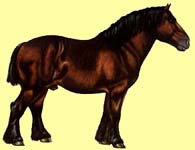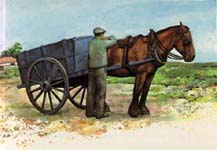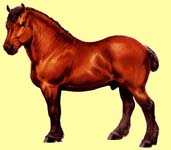|
|
Ardennais |
|
|
|
|
Ardennais |
|
|
 This heavy horse of the Ardennes region of France and Belgium is one of the oldest European heavy breeds and is regarded as the doyen of these drafters. The ancestors of the Ardennais were known some 2000 years ago, probably being the descendants of the snub-nosed, prehistoric horse whose remains have been found at Solutré. Prior to the 19th Century, the Ardennais was not as tall or as heavy as the modern representatives of the breed, and the horse was used under saddle and for light draft. Crosses made to the
Arabian and
Thoroughbred at the beginning of the 19th Century, as well as those made to the
Percheron and
Boulonnais, were not always very successful.
This heavy horse of the Ardennes region of France and Belgium is one of the oldest European heavy breeds and is regarded as the doyen of these drafters. The ancestors of the Ardennais were known some 2000 years ago, probably being the descendants of the snub-nosed, prehistoric horse whose remains have been found at Solutré. Prior to the 19th Century, the Ardennais was not as tall or as heavy as the modern representatives of the breed, and the horse was used under saddle and for light draft. Crosses made to the
Arabian and
Thoroughbred at the beginning of the 19th Century, as well as those made to the
Percheron and
Boulonnais, were not always very successful.
From these crosses three types of the Ardennais emerged. The small old-type Ardennais, which stands about 15 hands, is not found frequently today. The Ardennais du Nord, or Trait du Nord is a bigger horse which is derived from outcrosses to the Brabant. The Auxois is a larger version of the original Ardennais and it is very powerful. The Ardennais du Nord and the Auxois will be discussed later. Let's first look at the Ardennais of France.
The French Ardennais is a horse of the brachymorphic type, thought to be descended from a type of horse described by Julius Caesar in his De Bello Gallico, and it may even have directly descended from the Solutré horse. This horse, at the time of the Romans, measured barely 14 hands high. At the time of Napoleon, addition of Oriental blood improved its stamina and endurance. Its modern form and stature is a result of contributions by the Belgian Draft during the 19th Century, These horses were used by Napoleon in his Russian campaign, and the Russian Ardennais is probably descended from horses left behind in the retreat. Many of the Ardennais horses brought back Napoleon's wagons from this disastrous campaign.
The harsh climate in which these horses are reared has produced massively built horses which are very hardy. The exceptionally calm Ardennais is easily handled, and it is still used as a heavy draft horse, though for the most part, it is raised for the European meat market. This willing, hard worker has stamina and endurance, and is more thick-set than any other cart breed. Short and close to the ground, it's undoubted energy is derived from the Oriental outcrosses, and the size from the Belgian horses. Popular in Lorraine, it is still called "the cart horse of the north," but it is now used much today as a lively post horse. Registrations of this breed have been kept since 1929, and it is of international importance.
The French Ardennais stands 15 to 16 hands high and weighs 1,540 to 2,200 pounds, with the average being about 15.3 hands. Its coat may be roan, bay, dark chestnut, iron-grey, red roan or palomino. Light chestnuts and browns are tolerated, but black horses are excluded. It has a rather heavy head with pronounced jaws, a straight or snub profile and a broad face, and a low, flat forehead. The ears are small and pointed, the eyes are large and slightly prominent, and nostrils are flared. It has a short, muscular neck which is broad at the base and well set into the powerful shoulders, and though heavy it is longer than what would be expected in a large drafter. The withers are low, broad and muscular, and, unlike most drafters, they are in line with or lower than the croup. The chest is broad and deep and the shoulder is muscular and sloping.
Its body has an enormous bone structure, which is accompanied by musculature of corresponding strength. Its naturally deep girth gives it an overall impression of power. Its back is short, broad and straight, adding to the compact appearance. The exceptionally muscular loins are broad, and the croup is rounded. The Ardennais has particularly short, thick and powerful muscles in the quarters. Its sturdy, short and muscular legs have strong joints, broad feet, and they are heavily feathered. The lighter and quicker old-type Ardennais had less feathering on the legs. Though the hooves are smaller than one might expect in a heavy horse, they are strong and well formed. The Ardennais has a calm, but energetic temperament, and is strong with good endurance. It has an aptitude for heavy draft and farm work.
The Ardennes of Belgian and Sweden
 Once considered in some countries to be a division of the
Belgian Brabant, the Belgian Ardennes is now generally regarded as a division of the
French Ardennais. Originating from the Ardennes plateau, the Belgian Ardennes has been toughened into a hardy and frugal horse by the rigorous climate and very sparse pasture. It was once highly regarded by Julius Caesar and Nero, and in the 18th Century, it became ennobled with the introduction of Arabian blood. Napoleon used these horses for their exceptional endurance. In the 19th Century, characteristics distinguishing the present-day type were established. The Societé Royale pour le Cheval de Trait Ardennais records the genealogical records of this division of the Ardennais. This horse shares the same features as the French Ardennais.
Once considered in some countries to be a division of the
Belgian Brabant, the Belgian Ardennes is now generally regarded as a division of the
French Ardennais. Originating from the Ardennes plateau, the Belgian Ardennes has been toughened into a hardy and frugal horse by the rigorous climate and very sparse pasture. It was once highly regarded by Julius Caesar and Nero, and in the 18th Century, it became ennobled with the introduction of Arabian blood. Napoleon used these horses for their exceptional endurance. In the 19th Century, characteristics distinguishing the present-day type were established. The Societé Royale pour le Cheval de Trait Ardennais records the genealogical records of this division of the Ardennais. This horse shares the same features as the French Ardennais.
The Swedish Ardennes was developed from the Belgian and French Ardennais during the 19th Century. The characteristic docile temperament and massive compact appearance is inherited from both of these breeds. As a result of the mechanization of road transport, the Swedish Ardennes has suffered as a breed, but it continues to play an active role in the transport of timber in the mountainous regions. It is nationally important to Sweden.
 Standing 15 to 16 hands high, the Swedish Ardennes weighs 1,100 to 1,540 pounds.
Coat color may be
bay,
brown,
black, or
chestnut. It has a rather heavy head with a straight profile, broad forehead and full forelock, and small eyes. The short, muscular neck has a full mane, and the broad, muscular withers are not very pronounced. It has a short back, and muscular, rounded croup, which is often double. It has a sloping, muscular shoulder and a wide, deep chest. The short, sturdy legs have broad and strong joints and light feathering. The hoof is broad and round, and of tough horn. It has strong and hardy qualities, and is long-lived and frugal. The quiet and docile, but energetic, Swedish Ardennes has an aptitude for heavy draft and farm work.
Standing 15 to 16 hands high, the Swedish Ardennes weighs 1,100 to 1,540 pounds.
Coat color may be
bay,
brown,
black, or
chestnut. It has a rather heavy head with a straight profile, broad forehead and full forelock, and small eyes. The short, muscular neck has a full mane, and the broad, muscular withers are not very pronounced. It has a short back, and muscular, rounded croup, which is often double. It has a sloping, muscular shoulder and a wide, deep chest. The short, sturdy legs have broad and strong joints and light feathering. The hoof is broad and round, and of tough horn. It has strong and hardy qualities, and is long-lived and frugal. The quiet and docile, but energetic, Swedish Ardennes has an aptitude for heavy draft and farm work.
For more information on the Ardennais and Ardennes, visit:

|
© 1997-2007
NW Breyer Horse Club & Refiner of Gold Creations Equinealities in place since 1997, Section in place 2001, Updated 3/13/2007 |



|
| ||

|
|||||